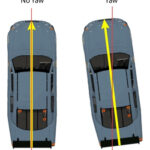ABS | Traction Control
Traction Control = ESP, VSA, VSC, TCS, VDC, DSC, ESC, ASC
ESP. Principle of Operation
ESC incorporates yaw rate control into the anti-lock braking system (ABS). Anti-lock brakes enable ESC to brake individual wheels. Many ESC systems also incorporate a traction control system (TCS or ASR), which senses drive-wheel slip under acceleration and individually brakes the slipping wheel or wheels and/or reduces excess engine power until control is regained. However, ESC achieves a different purpose than ABS or Traction Control.
The ESC system uses several sensors to determine what the driver wants (input). Other sensors indicate the actual state of the vehicle (response). The control algorithm compares driver input to vehicle response and decides, when necessary, to apply brakes and/or reduce throttle by the amounts calculated through the state space (set of equations used to model the dynamics of the vehicle). The ESC controller can also receive data from and issue commands to other controllers on the vehicle such as an all wheel drive system or an active suspension system to improve vehicle stability and controllability.
The sensors used for ESC have to send data at all times in order to detect possible defects as soon as possible. They have to be resistant to possible forms of interference (rain, holes in the road, etc.). The most important sensors are:
- Steering wheel angle sensor
- Yaw rate sensor
- Lateral acceleration sensor
- Wheel speed sensor
Others:
- Longitudinal acceleration sensor
- Roll rate sensor
ABS Module
- ABS Module Rebuild Service (http://modulemaster.com/)
Steering Angle Sensor
➱ Steering Angle Sensor (Quadrature Encoder)
➱📝 C1711 Steering Angle Sensor | SAS Adjustment Tip | 2018 Subaru Crosstrek
➱ 📝 C0071 Steering Angle Sensor Malfunction | Reflash + Calibration | Subaru, Toyota, Lexus
➱ 📝 00778 | Steering Angle Calibration | VW
Yaw Rate Sensor
Overview
- A Yaw Rate Sensor (or rotational speed sensor) measures a vehicle’s angular velocity about its vertical axis in degrees or radians per second in order to determine the orientation of the vehicle as it hard-corners or threatens to roll-over.
- Yaw can be defined as the movement of an object turning on its vertical axis. The yaw rate sensor determines how far off-axis a car is “tilting” in a turn using gyroscopes to monitor the slip angle, the angle between the vehicle’s heading and actual movement direction. This information is then fed into the vehicle’s computer to evaluate the wheel speed, steering angle and accelerator position, and, if the system senses too much yaw, the appropriate braking force is automatically applied.
- By comparing the vehicle’s actual yaw rate to the target yaw rate, the on-board computer can identify to what degree the vehicle may be under- or over-steering, and what corrective action, if any, is required. Corrective action may include reducing engine power as well as applying the brake on one or more wheels to realign the vehicle.
Failures
- During Yaw Sensor failure ESP might engage one of the brakes while driving straight ahead.
- “Yaw rate sensor not plausible” or “rotation rate sensor not plausible” means that during the plausibility testing, yaw rate values estimated from sensors (other than yaw rate sensor) compared with actual measured values (by the actual yaw rate sensor) are not close enough within a certain range/threshold. The message literally states that the measured rotation rate cannot be possible based on a comparison with estimated yaw rates from other sensors. The yaw rate can be estimated from the lateral (transverse) acceleration, steering angle sensor, and wheel speed sensors. Yaw rate can be estimated using two lateral acceleration sensors, but in this DSC implementation, there is only one lateral sensor. Yaw rate can be estimated from wheel speed sensors and lateral acceleration, and also with wheel speed sensors alone. Kalman filter is involved with estimation of the values.
Notes
- Yaw rate sensor usually needs to be calibrated after replacement.
➱📝 5F0E Steering Angle| Bad Yaw Rate Sensor | 2005 BMW X3
➱📝 84-01 Sensor Logic Failure | Bad Yaw Rate Sensor | 2006 Acura MDX
➱📝 Random self-steering to the right | Faulty Yaw Rate Sensor | 2004 Acura TSX
Lateral acceleration sensor or accelerometer
Lateral acceleration is an acceleration that is directed to the side (i.e. perpendicular to the direction of travel) incurred when a vehicle takes a curved path.
Longitudinal acceleration sensor
Longitudinal acceleration sensor is similar to the lateral acceleration sensor in design, but can offer additional information about road pitch and also provide another source of vehicle acceleration and speed.
Roll rate sensor
Roll rate sensor is similar to the yaw rate sensor in design but improves the fidelity of the controller’s vehicle model and correct for errors when estimating vehicle behavior from the other sensors alone.
Why is Bleeding Brakes Needed
- Hydraulics work so well because liquids are not compressible. You stomp on the brake pedal, you get 100% of the power generated directed to the brakes.
- When you mix air into the hydraulic brake lines you lose efficiency because air …a gas … will compress.
- So, when you stomp the brake pedal with air mixed in with the brake fluid, you do not get 100% of the power generated directed to the brakes; a portion is lost in compressing the trapped air.
- Also, air tends to have moisture in it.
- Brake fluid will readily absorb moisture …and this is why you need to regularly flush the old brake in your car’s brake system with new fluid.
- Trapped moisture will cause rust and can screw up brake wheel cylinders and brake calipers …not to mention the delicate anti-lock brake valving of the anti-lock brake system.
📖 Brakes Bleeding Procedure on Hybrid Vehicles

